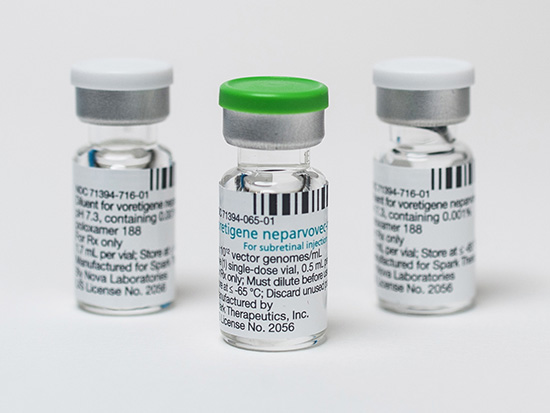Media contact: Adam Pope
 Luxturna uses a non-disease-causing virus to deliver a normal copy of the RPE65 gene to retinal cells, enabling them to make proteins capable of improving and preserving visual function.The University of Alabama at Birmingham Callahan Eye Hospital has been named one of the newest sites for Spark® Therapeutics’ LUXTURNA® (voretigene neparvovec-rzyl), the first FDA-approved gene therapy treatment for a genetic disease.
Luxturna uses a non-disease-causing virus to deliver a normal copy of the RPE65 gene to retinal cells, enabling them to make proteins capable of improving and preserving visual function.The University of Alabama at Birmingham Callahan Eye Hospital has been named one of the newest sites for Spark® Therapeutics’ LUXTURNA® (voretigene neparvovec-rzyl), the first FDA-approved gene therapy treatment for a genetic disease.
It is a prescription gene therapy used for the treatment of patients with inherited retinal disease due to mutations in both copies of the RPE65 gene, which can only be confirmed through genetic testing. Patients must have viable retinal cells as determined by the treating physicians.
Leber Congenital Amaurosis (LCA) is one retinal degenerative condition and a leading cause of genetic blindness in children. Patients with LCA start to lose their vision in the first five years of life, and it gets progressively worse as they age. Most patients are considered legally blind due to the profound vision loss it causes.
One subtype is caused by inherited mutations in both copies of the RPE65 gene. When patients have mutations in both of copies of their RPE65 gene, the normal visual cycle cannot take place, and retinal cells die over time.
LUXTURNA uses a non-disease-causing virus to deliver a normal copy of the RPE65 gene to retinal cells, enabling them to make proteins that have the potential to make the visual cycle work properly again.
Jason Crosson, M.D., and Richard Feist Jr., M.D., of Retina Consultants of Alabama will treat patients with RPE65 LCA, also known as LCA 2, at UAB Callahan Eye Hospital.
“We are excited to offer patients with this debilitating condition the opportunity to see more clearly in low light environments for the first time in their lives,” said Dawn DeCarlo, O.D., Ph.D., director of the UAB Center for Low Vision Rehabilitation in the Marnix E. Heersink School of Medicine. “Patients in our area who were previously identified as good candidates for LUXTURNA have had to travel to other states to receive treatment. It is exciting that we will now not only be able to offer patients from Alabama treatment right here at UAB Callahan Eye Hospital, but we will also be a destination treatment center for patients throughout the Southeast.”
UAB is now one of 14 treatment locations in the nation, and one of the few sites in the Southeast.
“Our location, in Birmingham, is an asset because of our reputation as a top national eye center and the accessibility of our city for those living in the Southeast,” said Brian Samuels, M.D., Ph.D., interim chair for the UAB Department of Ophthalmology and Visual Sciences. “I am extremely proud of Drs. Paul Gamlin, Douglas Witherspoon, Dawn DeCarlo, Jason Crosson and Richard Feist Jr., who were instrumental in UAB’s becoming a designated treatment center.”
“We have already been notified there are patients from Alabama and the Southeast who are interested in receiving treatment here,” Crosson said. “We look forward to meeting our new patients soon and scheduling them for treatment.”
LUXTURNA was developed by Spark Therapeutics. Patients interested in LUXTURNA should talk to their doctor to find out whether this treatment is right for them.